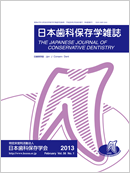Volume 52, Issue 1
Displaying 1-11 of 11 articles from this issue
- |<
- <
- 1
- >
- >|
Original Articles
-
Article type: Original Articles
2009 Volume 52 Issue 1 Pages 1-11
Published: February 28, 2009
Released on J-STAGE: March 30, 2018
Download PDF (4361K) -
Article type: Original Articles
2009 Volume 52 Issue 1 Pages 12-20
Published: February 28, 2009
Released on J-STAGE: March 30, 2018
Download PDF (1156K) -
Article type: Original Articles
2009 Volume 52 Issue 1 Pages 21-26
Published: February 28, 2009
Released on J-STAGE: March 30, 2018
Download PDF (2066K) -
Article type: Original Articles
2009 Volume 52 Issue 1 Pages 27-38
Published: February 28, 2009
Released on J-STAGE: March 30, 2018
Download PDF (4593K) -
Article type: Original Articles
2009 Volume 52 Issue 1 Pages 39-50
Published: February 28, 2009
Released on J-STAGE: March 30, 2018
Download PDF (1651K) -
Article type: Original Articles
2009 Volume 52 Issue 1 Pages 51-57
Published: February 28, 2009
Released on J-STAGE: March 30, 2018
Download PDF (1678K) -
Article type: Original Articles
2009 Volume 52 Issue 1 Pages 58-67
Published: February 28, 2009
Released on J-STAGE: March 30, 2018
Download PDF (41924K) -
Article type: Original Articles
2009 Volume 52 Issue 1 Pages 68-80
Published: February 28, 2009
Released on J-STAGE: March 30, 2018
Download PDF (2439K) -
Article type: Original Articles
2009 Volume 52 Issue 1 Pages 81-93
Published: February 28, 2009
Released on J-STAGE: March 30, 2018
Download PDF (1682K) -
Article type: Original Articles
2009 Volume 52 Issue 1 Pages 94-102
Published: February 28, 2009
Released on J-STAGE: March 30, 2018
Download PDF (2991K) -
Article type: Original Articles
2009 Volume 52 Issue 1 Pages 103-111
Published: February 28, 2009
Released on J-STAGE: March 30, 2018
Download PDF (1614K)
- |<
- <
- 1
- >
- >|
